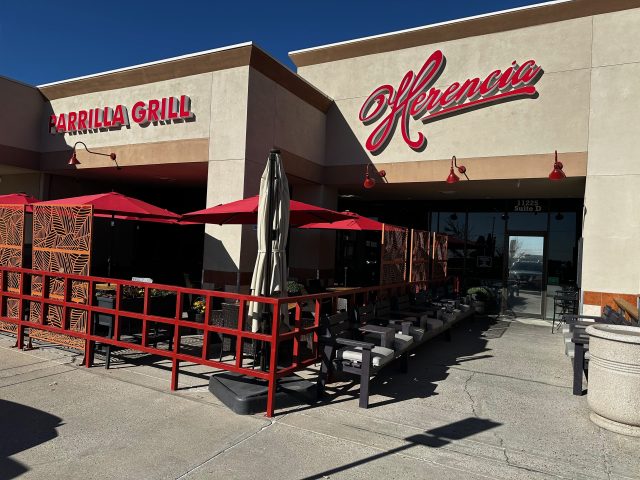
When he founded Los Equipales in 1996, restaurant impresario Henrique Valdovinos admitted “I wouldn’t have tried this ten years ago, but I think people are ready for it.” As recently as a quarter-century ago, two types of Mexican restaurants existed across the fruited plain. Most common were those sharing reciprocal expectations with diners who expected and received such stereotyped “Mexican” food as fajitas; hard-shelled tacos filled with ground beef, cheese, lettuce and sour cream; chiles rellenos made with bell peppers and enough yellow cheese to clog a dinosaur’s arteries. Denizens under the spacious skies didn’t know any better and enjoyed the watered down versions of the real deal. This “Mexican” food became mainstream.
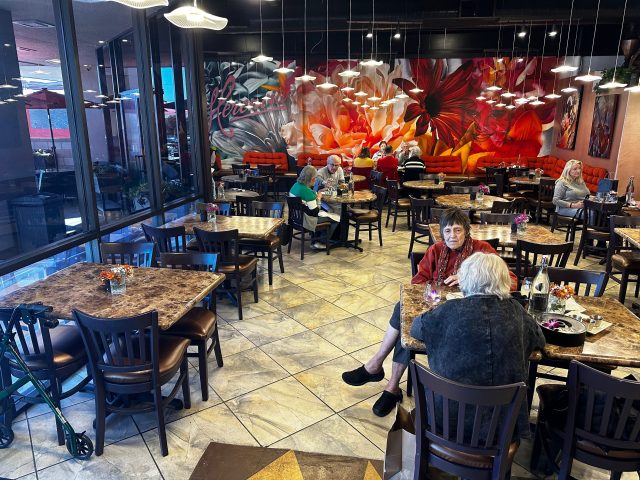
The other type of Mexican food restaurants might best be catgorized as “Mexican restaurants for Mexican people.” These restaurants didn’t offer “dumbed down” cuisine and were primarily (though not exclusively) frequented by scions of Montezuma. Among those which caught on across dining demographics were mariscos restaurants offering Mexican seafood options. None of the ubiquitous and mostly shuttered chains (Chi Chi’s, Don Pablo’s, Pancho’s, El Torrito, etal) served seafood. Mexican mom-and-pop restaurants began sprouting and having success by serving the foods enjoyed by Mexican families.
When he launched Los Equipales, Henrique Valdovinos hoped to “awaken the American palate to the true taste of Mexico.” Los Equipales served manjares del mar, seafood delicacies from the bounteous waters of coastal Mexico and traditional entrees from Old Mexico. Los Equipales celebrated the diverse cuisine of Mexico’s various regions by offering specialties unique to those regions for two week periods. Specialty dishes from each of Mexico’s 31 states were featured periodically to keep the menu fresh and interesting. It’s conceivable that Los Equipales would still be around had the restaurant stayed true to its traditional formula. Instead, the family which took over the restaurant changed things up.
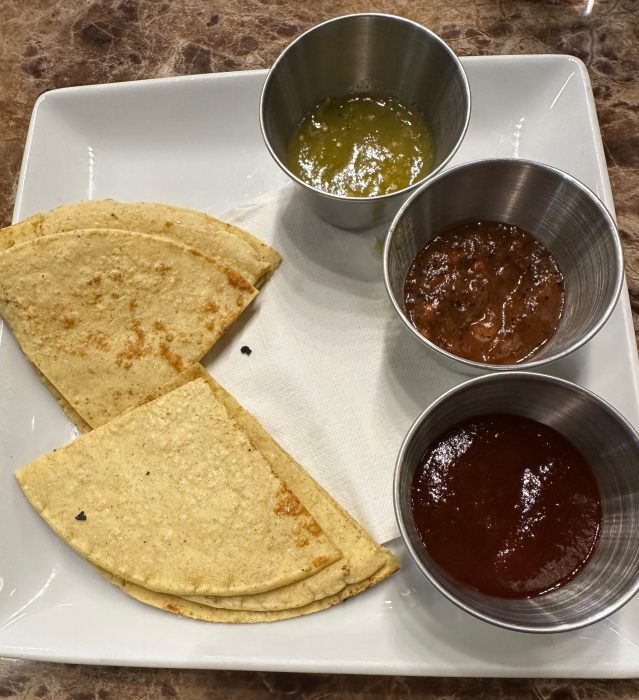
Chef Valdovinos, a grizzled veteran who helped pioneer Mexican cuisine authenticity in Albuquerque, doesn’t plan on compromising the integrity of authentic Mexican cuisine at Herencia, the Northeast Heights restaurant he launched in September, 2024. Herencia, a Spanish word with two related meanings–heritage and inheritance–is very important to the chef. Herencia is based on the rich legacy of his family in Mexico. That legacy is depicted on colorful murals on the east- and west-facing walls of the restaurant where his mother and grandmother are displayed among the colorful floral tapastry. Chef Valdovinos credits their influence on his cooking style which has been honed in more than fifty years of restaurant service.
Recipes passed down through generations are the hallmark of Herencia’s menu which focuses on the cuisine served in Mexico City, Guadalajara and Mazatlán. Having been raised in a modest environment on a diet of simple food, the talented chef has admittedly embellished some of those recipes while staying true to family traditions. Save for the choco flan, the menu is one-hundred percent gluten-free. Heirloom corn is used on the corn tortillas which are made from scratch as are salsas, moles, chorizos and even pickled jalapeños. Chef Valdovinos proudly boasts that virtually everything on the menu is created at the restaurant.
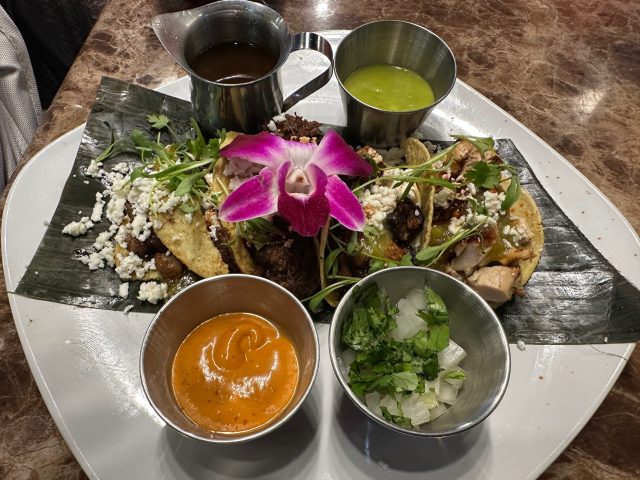
Herencia is located on the northeast corner of Montgomery and Juan Tabo, occupying the space which housed Zorba’s Fine Greek Dining from 2010 through 2023. Vestiges of the space’s previous tenant are nowhere to be found. Nor are some of the stereotypical trappings diners often associate with Mexican restaurants. By any standard, Herencia offers an upscale experience. That upscale experience is reflected in the personable service, embracing ambiance and a menu different from what many might believe to be Mexican. Chef Valdovinos is a peripatetic presence at Herencia, visiting every table to ensure guests are enjoying their experience. As much as restaurant volume will permit, he may even open the door for you to enter and exit the space.
As you peruse the lunch or dinner menu, your server will ferry over a trio of salsas and wedge-shaped corn tortillas. Heritage corn gives the corn tortillas a pronounced fresh corn flavor. You can fold the tortillas into “New Mexican spoons” and scoop up the salsas or dip them. One salsa is fashioned from three dried chiles–pasilla, guajillo and ancho–which serve as the base for Herencia’s mole. A tangy tomatillo salsa and a “salsa ranchera” (made with roasted vegetables) make up the complimentary trio. Other salsas are served with entrees.
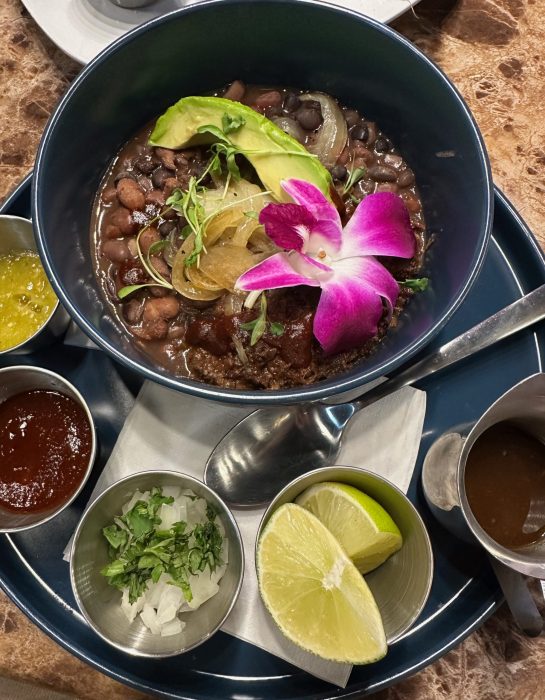
While most of us recognize the term “bocadillo” as the Spanish term for a sandwich, Herencias bocadillos menu lists three appetizer type dishes. Among them are assorted mini tacos, mini street tacos which showcase the corn tortillas on which those tacos are constructed. Though they may be mini, the flavors of these tacos is gigantic. You’ll instantly recognize the carne asada, marinated grilled beef taco sprinkled with queso fresco. It’s on par with the carne asada taco at Rio Tacos which means it’s “best of the city” caliber. My other favorite was the carne en su jugo (literally meat in its juices) taco, moist shredded beef seasoned to perfection. Pollo a las brazas (grilled chicken with garlic, lime and pasilla butter) and pork al pastor make up the other two.
As an entree, the aforementioned carne en su jugo is even better than enjoying the juicy meat in a taco. Carne en su jugo is a dish native to Guadalajara. Chef Valdovinos simmers top round beef in a tomatillo broth, shreds the beef and serves it with two type of whole beans. It may sound like a simple creation, but this dish is wonderful. Think comfort food wonderful. It’s a heart- and soul-warming dish you’ll crave every time the temperature drops. Carne en su jugo is served with three salsas, limes and a ramekin of onions with cilantro and a basket of fresh corn tortillas. It has only one fault–the bowl should be refilled two or three times.
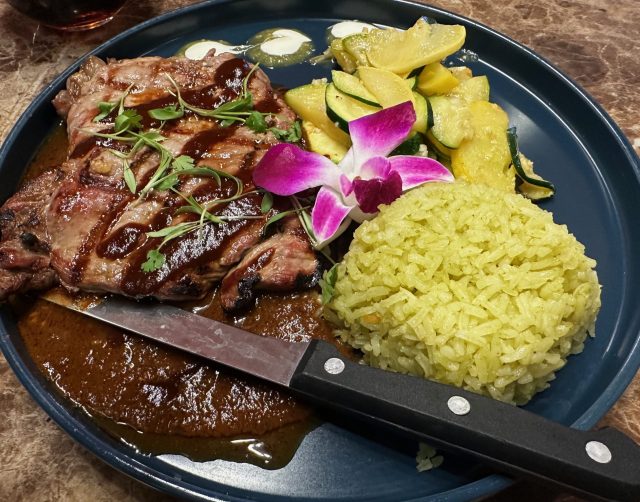
My carnivorous bride looked no further on the menu than the costilla de res (thin ribeye grilled and painted with guajillo and red mole sauces served with poblano pepper rice and fresh vegetables). Costilla de res translates to beef rib, though the ribeye comes from a piece of the rib section sliced into a smaller portion. Because the rib is tucked into an area of the cow that doesn’t do much work, ribeye is an utterly delicious steak. Depicted above is the costilla de res as described on the menu. My Kim, who thinks ketchup is piquant, sent it back and enjoyed the ribeye sans sauces. Aaargh! Admittedly the ribeye was absolutely delicious, but I can only dream about those sauces.
For dessert, Herencia offers four types of flan: cheese flan, pecan caramel flan, arroz con leche flan, coconut flan and a choco flan all served with housemade whipped cream. The choco flan is the only item on the menu that actually has gluten on it because of the chocolate cake. The marriage of chocolate cake and flan is made in a celestial kitchen. Topped with fresh strawberries, blueberries and blackberries and drizzled with caramel, it’s a memorable dessert. My Kim only thought she didn’t like flan. She thoroughly enjoyed this uniquely delicious flan though she indicated she’s looking forward to the planned future introduction of mango flan.

Herencia Parrilla Grill is a welcome departure from the days in which watered down Mexican restaurants fed throngs who didn’t know better. Welcome back Chef Valdovinos.
Herencia Parrilla Grill
11225 Montgomery Blvd., N.E., Suite D
Albuquerque, New Mexico
(505) 292-3776
Website | Facebook Page
LATEST VISIT: 16 November 2024
# OF VISITS: 1
RATING: N/R
COST: $$$
BEST BET: Chocoflan, Assorted Mini Tacos, Carne En Su Jugo, Costilla de Res
REVIEW #1432
One of the best Mexican restaurants I have been to. Enrique is truly talented. Jonny
I couldn’t agree more with you. Enrique is a phenomenal chef and entrepreneur.
Mole””
Carne””
Why is there an accent in Mazatlan but not on Chile””’?